
Autumn: "Season of mists and mellow fruitfulness". As far as I am concerned, the mellow fruitfulness means fungi. We don't take them seriously enough in Britain (leaving aside the expatriate Italian community, who know where the good stuff is, and will never tell you). I lived for a while in Catalonia and went with a colleague, Cristofol, on fungus forays into the pre-Pyrenees. I got a lot of tips from him, perhaps the most important of which was his response whenever I took a worthless fungus to him to ask if it was edible: "Pues, si, pero no hace falta," he would reply, which meant in effect "Well, you could eat it, but why bother when there are so many better ones to be had?" The truth is that most fungi are edible but not worth eating. A few are delicious, most are harmless, a few are deadly poisonous, and some aren't dangerous but would make you feel unwell. The trick is only to eat the ones you are sure of. Admire the rest but leave them be.
So, which ones are good to eat? In addition to the field mushroom that everyone knows, there are other Agarics, including the Wood Mushroom, which are just as eatable. 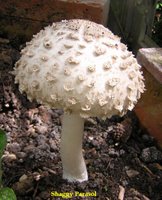 There are the Parasols (Macrolepiota procera, which is delicious; and M. rhacodes, the Shaggy Parasol, which is coarser but still good eating).
There are the Parasols (Macrolepiota procera, which is delicious; and M. rhacodes, the Shaggy Parasol, which is coarser but still good eating). 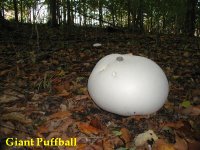 There's the Giant Puffball when it's fresh.
There's the Giant Puffball when it's fresh.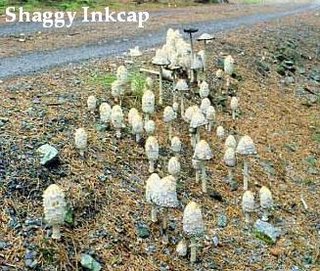 And there's the Shaggy Inkcap Coprinus comatus, sometimes called Lawyer's Wig. Fry your bacon and then cook the shaggies in the fat, and to hell with your calorie-controlled diet. Delicious! Also, when it's fresh. there's its cousin C. atramentarius: also good eating, but avoid alcohol or you will get the collywobbles.
And there's the Shaggy Inkcap Coprinus comatus, sometimes called Lawyer's Wig. Fry your bacon and then cook the shaggies in the fat, and to hell with your calorie-controlled diet. Delicious! Also, when it's fresh. there's its cousin C. atramentarius: also good eating, but avoid alcohol or you will get the collywobbles.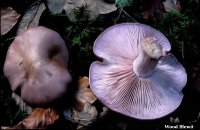 If you can find them, the Blewits are delicious despite their disconcerting blueish or purplish blush.
If you can find them, the Blewits are delicious despite their disconcerting blueish or purplish blush.
Under birch, you might find one of the Lactarius species (so-called because they "lactate" - ooze a milky liquid - when cut). This one is L. piperatus, the Pepper Mushroom. Break off a little piece and test the milk with the tip of your tongue. Chilli peppers are mild by comparison. Chanterelles are aristocrats among fungi. The "boleteieres" or fungus collectors, of Catalonia make a good living providing "rovellons" - Chanterelles - for the restaurants. These bright orange beauties with their copper-sulphate stains are startling to behold but divine to eat cooked in garlic. But take care you do not confuse them with one of the Clitocybes, which will do you no good at all.
Chanterelles are aristocrats among fungi. The "boleteieres" or fungus collectors, of Catalonia make a good living providing "rovellons" - Chanterelles - for the restaurants. These bright orange beauties with their copper-sulphate stains are startling to behold but divine to eat cooked in garlic. But take care you do not confuse them with one of the Clitocybes, which will do you no good at all.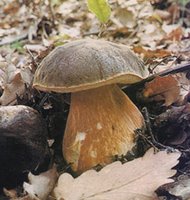 There's a whole family of fungi, the Boletus species, which have spongy gills. The most famous must be the Cep Boletus edulis, which French gourmets will kill for. The various Boletes are mostly associated with particular trees, so in my woodland-poor area, we are not likely to find many.
There's a whole family of fungi, the Boletus species, which have spongy gills. The most famous must be the Cep Boletus edulis, which French gourmets will kill for. The various Boletes are mostly associated with particular trees, so in my woodland-poor area, we are not likely to find many. 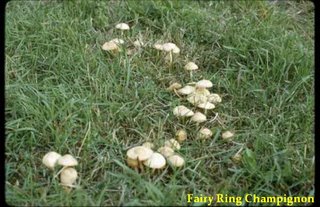 Closer to home: if you are lucky you might have Fairy Ring mushrooms Marasmius oreades growing on your lawn. Instead of cursing them, pick them, dry them and use them in winter soups.
Closer to home: if you are lucky you might have Fairy Ring mushrooms Marasmius oreades growing on your lawn. Instead of cursing them, pick them, dry them and use them in winter soups.
For those looking for thrills, there are some naughty "magic" fungi, one of which, Paneolus sphinctrinus, is a cowpat-lover. If you find the quintessential toadstool, the Fly Agaric, that's the one with the red cap covered in white bits, you could always bite off a piece and see if you end up in a Yellow Submarine, but no more than a nibble, or you might end up in a Pine Box. Of course, our Nanny Government has made it illegal to pick magic mushrooms.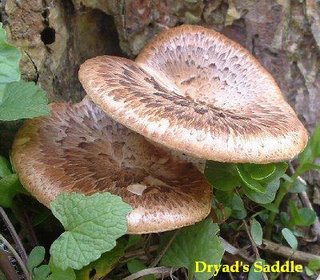 But, eating apart, there are many species of fungus which are just very pretty to look at. My favourite is the one called "Little Japanese Umbrella" and you will know it immediately you see it - probably on your lawn - because that is what it looks like. Others are spectacular, like the bracket fungi, which attach themselves to the boles of trees. Dryad's Saddle is a good example.
But, eating apart, there are many species of fungus which are just very pretty to look at. My favourite is the one called "Little Japanese Umbrella" and you will know it immediately you see it - probably on your lawn - because that is what it looks like. Others are spectacular, like the bracket fungi, which attach themselves to the boles of trees. Dryad's Saddle is a good example.
There are many books to help you identify fungi, but the only one I can recommend is Mushrooms and Other Fungi of Great Britain by Roger Phillips, published by Pan Books. Excellent photographs.
One last word: brightly-coloured fungi are not necessarily dangerous, pale "mushroom"-coloured fungi are not necessarily safe. As for magic mushrooms, if you find any, leave them alone, but do send me the Grid Reference. Immediately.

2 comments:
Perhaps one should go armed hunting the Boletus edulis, lest one encounter a desperate French gourmet.
Actually, here in southern Colorado, it was elderly German ladies (GI brides, I think), who introduced my wife and me to the boletes on the lower slopes of Pike's Peak.
One more thing, Andy Letcher's Shroom: A Cultural History of the Magic Mushroom has a great deal on British mushroom-hunting history.
He completely explodes Gordon Wasson's mycophobe/mycophile distinction.
Post a Comment